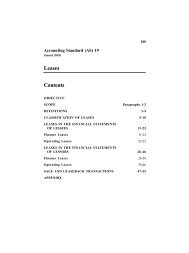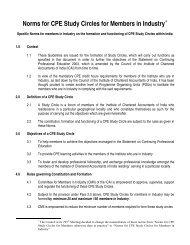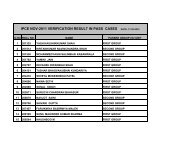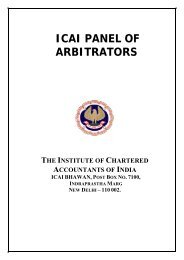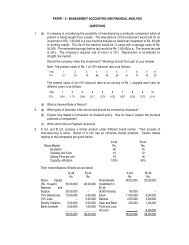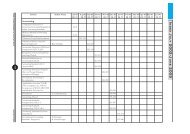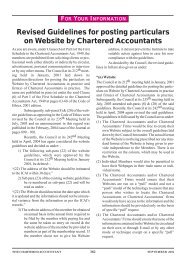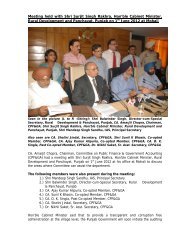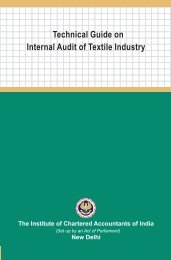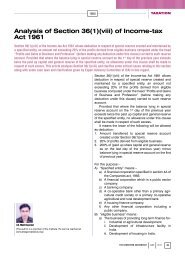The Chartered Accountant
The Chartered Accountant
The Chartered Accountant
You also want an ePaper? Increase the reach of your titles
YUMPU automatically turns print PDFs into web optimized ePapers that Google loves.
process is the stage of ‘controls<br />
gap’ analysis.<br />
Segregation of Duties<br />
15. Segregation of duties is critical<br />
to effective internal control; it<br />
reduces the risk of both erroneous<br />
and inappropriate actions. <strong>The</strong> internal<br />
auditor should ensure that<br />
in general, the approval function,<br />
the accounting/reconciling<br />
function, and the asset custody<br />
function is separated among employees<br />
of the entity. When these<br />
functions cannot be separated due<br />
to small department size, the internal<br />
auditor should ensure that<br />
a detailed supervisory review of<br />
related activities is in practice, as<br />
a compensating control activity.<br />
Segregation of duties is a deterrent<br />
to fraud because it requires collusion<br />
with another person to perpetrate a<br />
fraudulent act.<br />
Control Activities for Information<br />
Technology<br />
16. In a computer information systems<br />
environment, the objectives of<br />
tests of control do not change from<br />
those in a manual environment; however,<br />
some audit procedures may<br />
change. <strong>The</strong> internal auditor may<br />
find it necessary, or may prefer, to<br />
use computer-assisted audit techniques.<br />
<strong>The</strong> use of such techniques,<br />
for example, file interrogation tools<br />
or audit test data, may be appropriate<br />
when the accounting and internal<br />
control systems provide no visible<br />
evidence documenting the performance<br />
of internal controls which<br />
are programmed into a computerised<br />
accounting system. <strong>The</strong>re are<br />
two broad categories of information<br />
systems control - general control and<br />
application control. General control<br />
applies to all information systemsmainframe,<br />
minicomputer, network,<br />
and end-user environments. Application<br />
control is designed to cover the<br />
processing of data within the application<br />
software.<br />
17. While evaluating the infor-<br />
EXPOSURE DRAFTS<br />
mation technology controls in a<br />
system-driven environment, the<br />
internal auditor should determine<br />
whether the entity, inter alia,<br />
uses:<br />
l encryption tools, protocols,<br />
or similar features of software<br />
applications that protect<br />
confidential or sensitive<br />
information from unauthorized<br />
individuals;<br />
l back-up and restore features<br />
of software applications that<br />
reduce the risk of lost data;<br />
l virus protection software;<br />
l passwords that restrict user<br />
access to networks, data and<br />
applications.<br />
18. <strong>The</strong> nature, timing and extent<br />
of the procedures performed by<br />
the internal auditor to obtain an understanding<br />
of the internal control<br />
systems will vary with, among other<br />
things:<br />
m <strong>The</strong> size and complexity of the<br />
entity and of its information<br />
system.<br />
m Materiality considerations.<br />
m <strong>The</strong> type of internal controls<br />
involved.<br />
m <strong>The</strong> nature of the entity’s documentation<br />
of specific internal<br />
controls.<br />
m <strong>The</strong> internal auditor’s assessment<br />
of inherent risk.<br />
19. Ordinarily, the internal auditor’s<br />
understanding of the internal control<br />
systems significant to the audit is obtained<br />
through previous experience<br />
with the entity and is supplemented<br />
by:<br />
a. inquiries of appropriate management,<br />
supervisory and<br />
other personnel at various organisational<br />
levels within the<br />
entity, together with reference<br />
to documentation, such as procedures<br />
manuals, job descriptions,<br />
systems descriptions and<br />
flow charts;<br />
b. inspection of documents and<br />
records produced by the accounting<br />
and internal control<br />
systems;<br />
c. observation of the entity’s activities<br />
and operations, including<br />
observation of the organisation<br />
of computer operations,<br />
personnel performing control<br />
procedures and the nature of<br />
transaction processing.<br />
Test of Controls<br />
20. Tests of control are performed<br />
to obtain audit evidence about the effectiveness<br />
of the:<br />
a. design of the internal control<br />
systems, that is, whether they<br />
are suitably designed to prevent<br />
or detect and correct material<br />
misstatements;<br />
b. operation of the internal controls<br />
throughout the period;<br />
c. cost of a control vis a vis the<br />
benefit obtained from the<br />
same.<br />
21. Tests of control normally include:<br />
m Inspection of documents supporting<br />
transactions and other<br />
events to gain audit evidence<br />
that internal controls have operated<br />
properly, for example,<br />
verifying that a transaction has<br />
been authorised.<br />
m Inquiries about, and observation<br />
of internal controls<br />
which leave no audit trail.<br />
For example, determining<br />
who actually performs each<br />
function and not merely who<br />
is supposed to perform it.<br />
m Re-performance of internal<br />
controls. For example, reconciliation<br />
of bank accounts,<br />
to ensure they were correctly<br />
performed by the entity.<br />
m Testing of internal control<br />
operating on specific comput-<br />
THE CHARTERED ACCOUNTANT 1115 DECEMBER 2008



